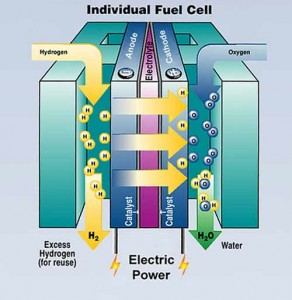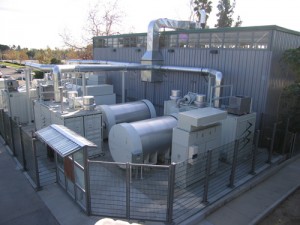Hydrogen fuel cells are to renewable energy what the paperless office is to business: a good idea that never seems to take off. The difference is that hydrogen cells, in all likelihood, will take off in the not-too-distant future. Investors have put a boatload of cash into fuel cell development, the underlying science is sound, and society is more open to environmentally friendly energy sources than it ever has been.
 Even when they hit the market in earnest, however, I’m skeptical that hydrogen cells will revolutionize the motor vehicle industry, as hyped. Hybrid gas/electric technology is years ahead of hydrogen cells in the automotive market, and auto companies are making huge strides in hybrid technology. Just last week at the Frankfurt Auto Show, Volkswagen unveiled a two-passenger concept car that gets 240 miles per gallon. Hydrogen fuel cell makers, by comparison, don’t even have production models on the road yet.
Even when they hit the market in earnest, however, I’m skeptical that hydrogen cells will revolutionize the motor vehicle industry, as hyped. Hybrid gas/electric technology is years ahead of hydrogen cells in the automotive market, and auto companies are making huge strides in hybrid technology. Just last week at the Frankfurt Auto Show, Volkswagen unveiled a two-passenger concept car that gets 240 miles per gallon. Hydrogen fuel cell makers, by comparison, don’t even have production models on the road yet.
There might be room in the automotive industry for more than one power plant architecture, but there’s a better play for hydrogen cells – powering large buildings. There are two reasons. The first is that hydrogen cells generate heat as well as electricity. In small-scale applications like cars and homes, that heat is most likely wasted. Commercial buildings are large enough to support cogeneration systems that can capture the heat from hydrogen cells and use it either for heating or to turn steam turbines for generating more electricity.
The second reason is that hydrogen fuel cells require an energy source to produce the necessary hydrogen. Many automotive fuel cells use compressed hydrogen as their energy source, but it takes almost as much energy to produce compressed hydrogen as a fuel cell produces. Buildings, by contrast, can use any number of existing energy sources to power their fuel cells, and buildings adapt more easily to renewable energy sources such as biomass.
 Hydrogen cells might be the greenest technology for powering vehicles, but history has proven time after time that incumbent technologies are hard to beat if they’re cost effective and do a good, if not great job. Look at Ethernet versus ATM (asynchronous transfer mode) in networking. ATM was faster and could support more services, but Ethernet was capable, inexpensive and well established by the time ATM came along. Ethernet remained the dominant local area networking protocol, but ATM found its niche in wide-area networking. Hydrogen fuel cells are looking at a similar situation. Hybrid vehicle technology is here and now and it yields good fuel economy at a reasonable environmental cost. That’s a moving target that hydrogen fuel cells can’t hit. Better to focus on a market where their adaptability makes them the technology to beat.
Hydrogen cells might be the greenest technology for powering vehicles, but history has proven time after time that incumbent technologies are hard to beat if they’re cost effective and do a good, if not great job. Look at Ethernet versus ATM (asynchronous transfer mode) in networking. ATM was faster and could support more services, but Ethernet was capable, inexpensive and well established by the time ATM came along. Ethernet remained the dominant local area networking protocol, but ATM found its niche in wide-area networking. Hydrogen fuel cells are looking at a similar situation. Hybrid vehicle technology is here and now and it yields good fuel economy at a reasonable environmental cost. That’s a moving target that hydrogen fuel cells can’t hit. Better to focus on a market where their adaptability makes them the technology to beat.